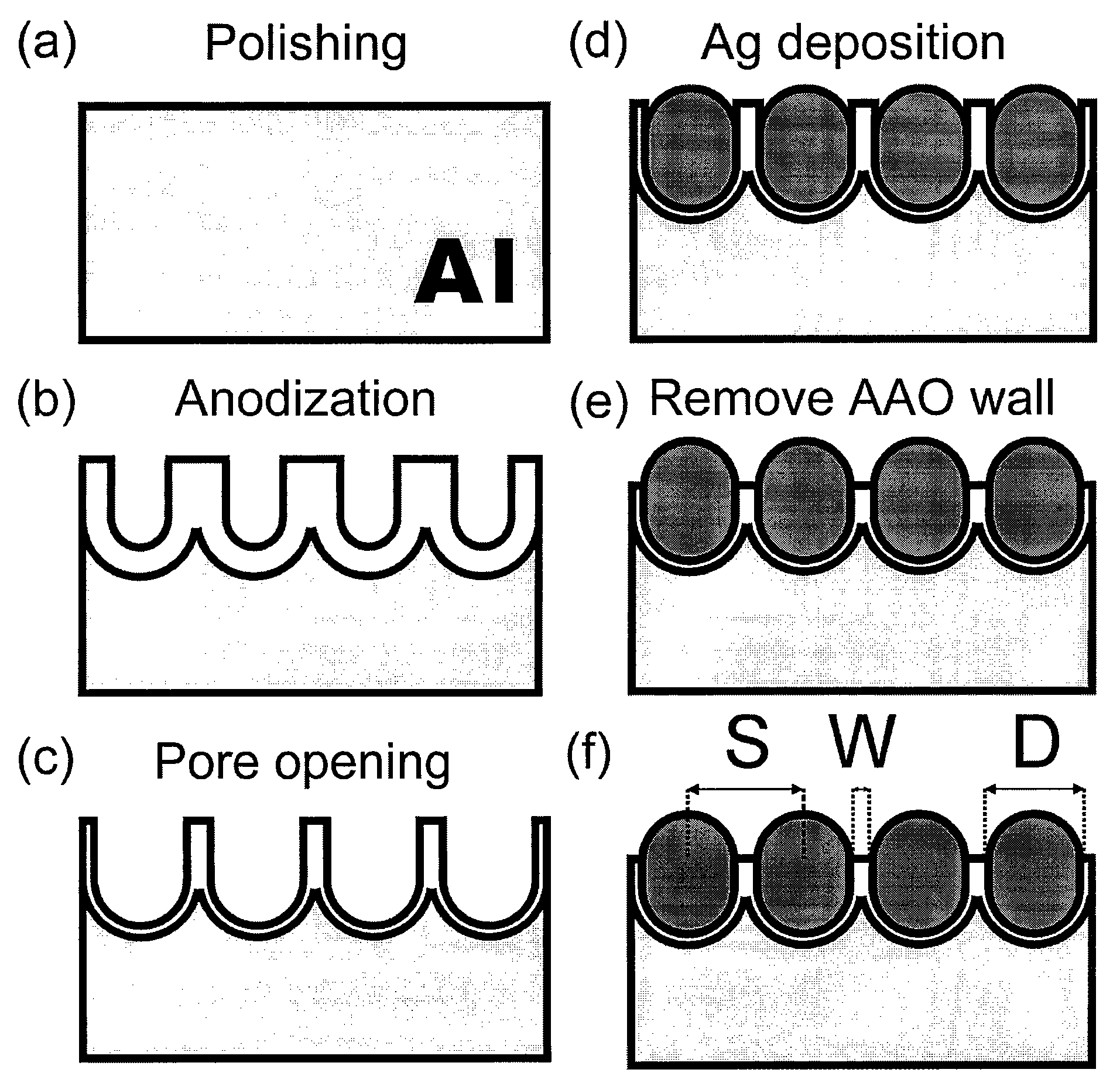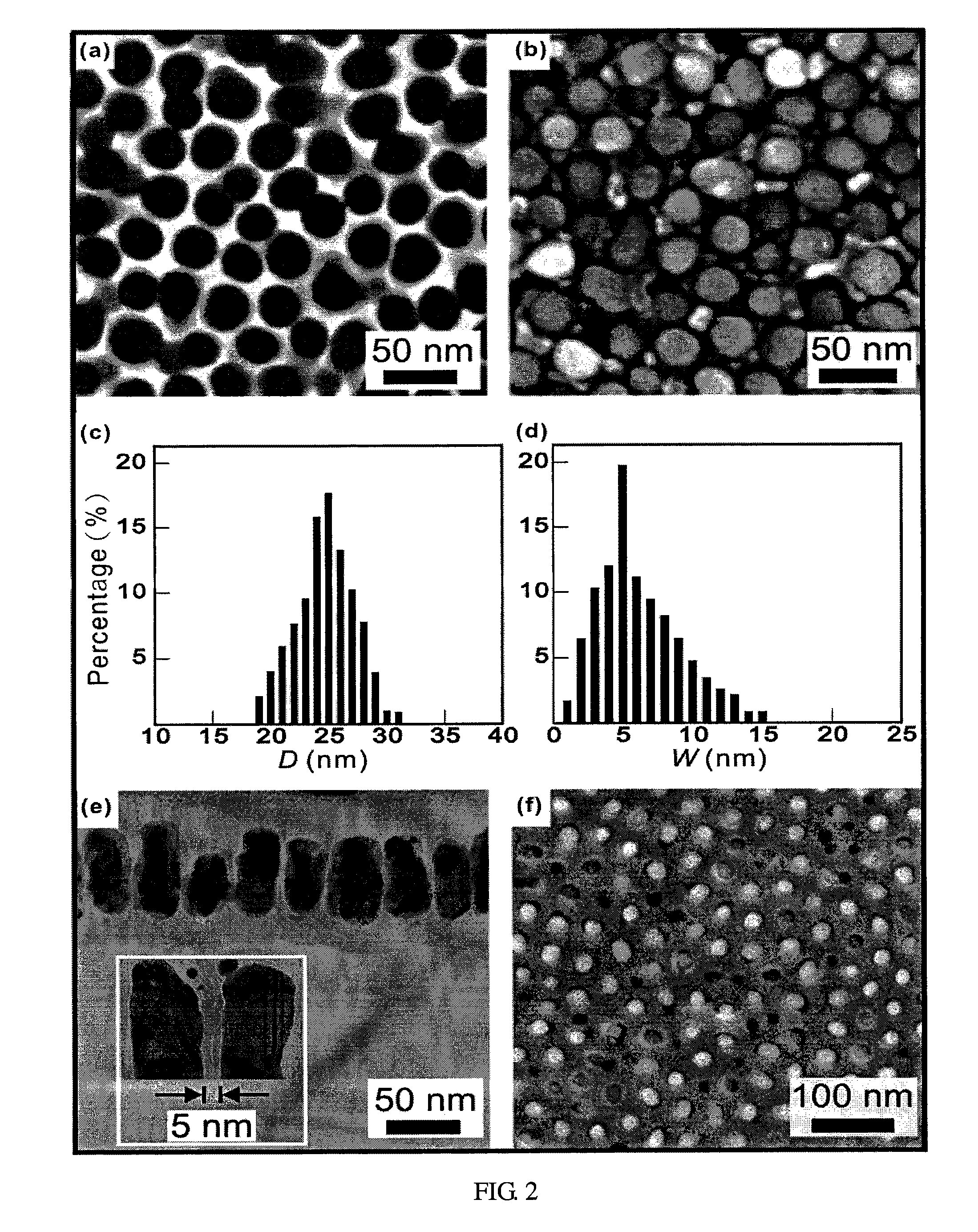Substrate for surface-enhanced raman spectroscopy, sers sensors, and method for preparing same
a technology of raman spectroscopy and substrate, which is applied in the field of substrate for surface-enhanced raman spectroscopy, sers sensors, and method for preparing same, can solve the problems of difficult precise control of the gaps between nanostructures on a sers-active substrate in the sub-50 nm range, and the detection sensitivity of raman spectroscopy. achieve the effect of enhancing the power of sers
- Summary
- Abstract
- Description
- Claims
- Application Information
AI Technical Summary
Benefits of technology
Problems solved by technology
Method used
Image
Examples
example 1
[0040]Procedures of Preparing SERS-Active Substrate
[0041]High purity (99.99%) annealed aluminum foil is electro-polished in a mixture of HClO4 and C2H5OH (volume ratio 1:5) until the root-mean-square surface roughness of a typical 10 μm2×10 μm area is 1 nm, as measured by an atomic force microscope operated in contact mode. The foil is then anodized in sulfuric acid (0.3 M) at 5° C. using a voltage in the range between 10-30 V to achieve the growth of an array of pits in the AAO substrate. See FIG. 1(b). The pits in the AAO substrate are then enlarged. For example, the substrate may be etched in 5% phosphoric acid to increase the diameters of the pits. See FIG. 1(c). By carefully controlling the etching process, arrays of pits with 5±2 nm inter-pit spacing (W) are achieved. See FIG. 1(f). An electrochemical plating procedure is then employed to grow Ag-nanoparticles into the AAO substrates. See FIG. 1(d). For growing Ag-nanoparticles into the AAO pits, an alternating current (AC) (9...
example 2
[0042]Procedure for Carrying Out SERS Analysis
[0043]Raman spectroscopy measurements are performed on a micro-Raman setup with an argon ion laser at 514.5 nm. After passing through a narrow bandpass filter to remove residual plasma lines, the laser beam is focused by a 100× water-immersion objective lens (N.A.=0.95) to a ˜1 μm spot in a drop of the desired solution on a Ag / AAO substrate with a corresponding beam intensity of ˜105 W / cm2. The scattering radiation, after being collected by the same objective lens, is sent through a Raman notch filter to a 64-cm monochromator. The dispersed spectrum is then detected by a LN2-cooled charge-coupled device (CCD) camera. The low laser power density used for the measurements eliminates the side effects of local heating, deformation of Ag-nanoparticles, and photo-oxidation during laser illumination.
example 3
[0044]Testing the Raman Enhancing Power of the Ag / AAO Substrate
[0045]To test the Raman enhancing power of the Ag / AAO substrates, water solution (10−6 M) of rhodamine 6G (R6G) is applied to a substrate with W=5 nm and D=25 nm, and SERS spectrum is recorded. As shown in FIG. 3A, very large Raman peaks are observed when the fluorescence background is quenched to a steady state in a few minutes after the application of the solution. The large SERS signal indicates that the R6G molecules near the Ag-nanoparticles are excited by the laser-induced surface plasmon, while the fluorescence quenching suggests that some of R6G analyte had been spontaneously adsorbed onto the surface of nanoparticles. As shown in FIG. 3A, the enhancement factor of the Ag / AAO substrate is at least 105 times larger than that of a SERS substrate prepared by depositing ˜30 nm of Ag onto a silicon surface, which does not provide any detectable SERS signal above the fluorescence background. The above-mentioned enhanci...
PUM
 Login to View More
Login to View More Abstract
Description
Claims
Application Information
 Login to View More
Login to View More - R&D
- Intellectual Property
- Life Sciences
- Materials
- Tech Scout
- Unparalleled Data Quality
- Higher Quality Content
- 60% Fewer Hallucinations
Browse by: Latest US Patents, China's latest patents, Technical Efficacy Thesaurus, Application Domain, Technology Topic, Popular Technical Reports.
© 2025 PatSnap. All rights reserved.Legal|Privacy policy|Modern Slavery Act Transparency Statement|Sitemap|About US| Contact US: help@patsnap.com



